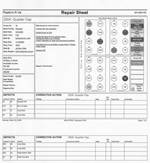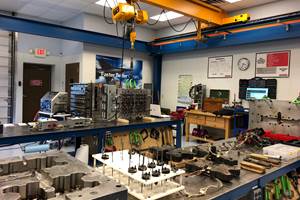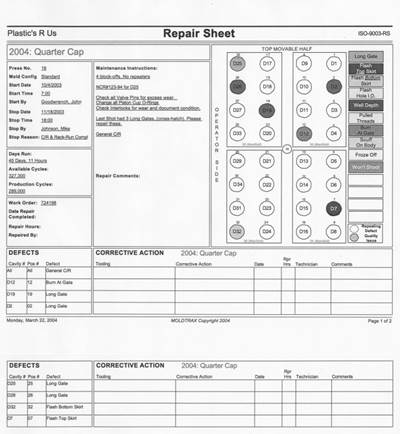Across the Bench - Creating a Repair Plan
The last shot is the most important key to insuring accurate mold repair.
Last month, we discussed how to collect accurate mold performance data at the press through the use of an IML (injection mold layout) sheet. We will now begin to consolidate the IML, last shot inspection and past maintenance issues to create our repair plan.
Different Strokes
Creating a repair plan for some companies usually means setting a mold on a repair technician's bench with instructions such as "mold flashing, fix it." Other companies might have a log or notebook that follows the mold, which the technician must decipher and then decide what to fix. Without a repair plan, critical downtime hours will be wasted determining exactly what to do.
A systematic approach to creating a repair plan is based on the idea of breaking down performance and maintenance information into categorized mold events. These include specific mold and part defect descriptions, probable causes, corrective actions and preventative actions. Doing this requires a professional discipline and regimented process that is foreign to many maintenance shops in the U.S. It is an area where we need to change our firefighting culture to improve our stance with foreign competition.
Last Shot
When the toolroom receives the IML and last shot from processing, the technician must examine the last shot samples for hidden part quality issues. The last shot is an important key to insure accurate mold repair. Unfortunately, many Q/A departments are not required to document parts that are close to specification limits, only those that are over. The last shot may also contain defective parts that either slip by Q/A or have become defect issues after the last Q/A check, just before the mold is shut down and pulled.
There are no painless methods to get this critical information included on the repair plan. Someone from Q/A, metrology, processing or the toolroom must inspect the last shot for one or two of these issues:
- All observed flash lengths;
- All flagged flash more than half the maximum allowable amount;
- Finish observations close to being nonconformance issues.
Many shops disregard the last shot because there is no formal policy in place that designates who is responsible for collecting and recording this data. It is less confrontational and incorrectly assumed that the last shot holds no relevant mold maintenance information worth the time it takes to collect and inspect. However, for the toolroom technician, there is no better indicator of the overall health of a mold than examining the last shot of a mold running in a specified process.
It is not uncommon for a multicavity mold coming off a 400,000-cycle run to have several cavities close to the maximum allowable flash limit in the last shot. Choosing to repair these defects will be based on careful consideration of:
- Available repair time;
- Available tooling;
- Historical data (past last shot measurements) of flash.
Occasionally, we will choose not to implement corrective action for a part with nominal flash. By continuing to monitor the part, repair technicians will improve their ability to forecast tooling life by visually and physically relating worn tooling to growing flash lengths. Continuous comparison of flash to tooling wear under a microscope is valuable experience that will allow repair technicians to maximize tooling life and make better decisions.
It also is a good test for the stability of a molding process. If 0.020 flash is here one day and either gone or doubled in length the next, with no corrective action performed by the toolroom, it begs the question, "What else has changed?" Once the last shot has been inspected, a determination is made as to what defects will be corrected. This information is then included on the repair sheet.
Next month, the plan comes together.
Related Content
Think Safety: Eliminate Hazards Throughout the Shop
The tooling community is taking advantage of new products for safer mold shops and molding facilities.
Read More5 Hot Runner Tips for Moldmakers and Molders
Best practices for initial hot runner tryouts and effective preventive maintenance.
Read MoreWhat You Need to Know About Hot Runner Systems and How to Optimize Their Performance
How to make the most out of the hot runner design, function and performance.
Read MoreThe Ins and Outs of Hot Runner Temperature Control
A training checklist that explains the why and how of proper hot runner temperature control and system management.
Read MoreRead Next
Across the Bench - The Plan Comes Together
The repair sheet is critical to the success of any mold repair plan.
Read MoreReasons to Use Fiber Lasers for Mold Cleaning
Fiber lasers offer a simplicity, speed, control and portability, minimizing mold cleaning risks.
Read MoreAre You a Moldmaker Considering 3D Printing? Consider the 3D Printing Workshop at NPE2024
Presentations will cover 3D printing for mold tooling, material innovation, product development, bridge production and full-scale, high-volume additive manufacturing.
Read More





















